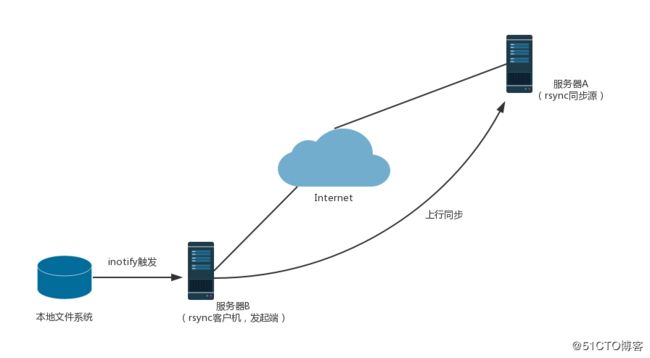概述
rsync是一个开源的快速备份工具,可以再不同主机之间镜像同步整个目录树,支持增量备份,保持链接和权限,且采用优化的同步算法,再传输前执行压缩,因此非常适用于异地备份、镜像服务器等应用。
原理
再远程同步任务中,负责发起rsync同步操作的客户机称为发起端,而负责响应来自客户机的rsync同步操作的服务器称为同步源。再同步过程中,同步源负责提供文档的原始位置,而发起端对该位置具有读取权限,如图所示:
配置rsync源服务器
1.检查rsync是否安装
[root@localhost ~]# rpm -q rsync
rsync-3.0.9-18.el7.x86_642.修改rsync默认配置文件,位于/etc/rsyncd.conf。
插入以下内容
uid = nobody
gid = nobody
use chroot = yes //禁锢在源目录//
address = 192.168.126.138 //监听地址//
port 873 //监听端口//
log file = /var/log/rsyncd.log //日志文件位置//
pid file = /var/run/rsyncd.pid //存放进程ID的文件位置//
hosts allow = 192.168.126.0/24 //允许访问的客户机地址//
# max connections = 4
# pid file = /var/run/rsyncd.pid
# exclude = lost+found/
# transfer logging = yes
# timeout = 900
# ignore nonreadable = yes
# dont compress = *.gz *.tgz *.zip *.z *.Z *.rpm *.deb *.bz2
[wwwroot] //共享模块名称//
path = /var/www/html //源目录的实际路径//
read only = no //是否为只读//
dont compress = *.gz *.tgz *.zip *.z *.Z *.rpm *.deb *.bz2 //同步时不再压缩的文件类型//
auth users = backuper //授权账户//
secrets file = /etc/rsyncd_users.db //存放账户信息的数据文件//3.为备份账户创建数据文件
根据上一步的设置,创建账号数据文件,添加一行用户记录,以冒号分隔,用户名称为backup,密码为abc123。由于账号信息采取明文存放,因此应调整文件权限,避免账号信息泄露。
[root@localhost ~]#vim /etc/rsyncd_users.db
backuper:abc123
[root@localhost ~]#chmod 600 /etc/rsyncd_users.db4.开启rsync服务,运行参数为 --daemon。
[root@localhost opt]# systemctl stop firewalld.service
[root@localhost opt]# setenforce 0
[root@localhost opt]# rsync --daemon
[root@localhost opt]# netstat -ntap | grep rsync
tcp 0 0 0.0.0.0:873 0.0.0.0:* LISTEN 2934/rsync 使用rsync备份工具
配置源的方法:
在执行运程同步任务时,rsync命令需要指定同步源服务器中的资源位置。rsync同步源的资源表示方式为“用户名@主机地址::共享模块名”或者“rsync://用户名@主机地址/共享模块名”,前者为两个冒号分隔形式,后者为URL地址形式。
rsync -avz [email protected]::wwwroot /opt/
rsync -avz rsync://[email protected]/wwwroot /opt/1.执行以下操作将源服务器中的wwwroot共享模块,下载到客户机的本地/var/www/html目录下。
源服务器:
[root@localhost ~]# cd /var/www/html/
[root@localhost html]# echo "123" > 111.txt
[root@localhost html]# echo "456" > 222.txt
[root@localhost html]# ls
111.txt 222.txt
客户端:
[root@localhost opt]# rsync -avz [email protected]::wwwroot/ ./ //下载到当前目录//
Password:
receiving incremental file list
./
111.txt
222.txt
sent 102 bytes received 221 bytes 23.93 bytes/sec
total size is 8 speedup is 0.02
[root@localhost html]# ls
111.txt 222.txt
2.在客户端上传文件到源服务器
[root@localhost opt]#mkdir b1 b2 b3 b4
[root@localhost opt]# ls
b1 b2 b3 b4 b5 rh
[root@localhost opt]# rsync -avz [email protected]::wwwroot/ ./ #上传
Password:
receiving incremental file list
./
111.txt
222.txt
sent 102 bytes received 221 bytes 23.93 bytes/sec
total size is 8 speedup is 0.02 #上传成功
源服务器上查看:
[root@localhost ~]# cd /var/www/html/
[root@localhost html]# ls
b1 b2 b3 b4 b5 rh
注意:
上传前需要把源服务器rsync的配置文件rsyncd.conf中的uid、gid修改为root配置rsync+inotify实施同步
将rsync工具与inotify机制相结合,可以实现触发式备份(实时同步)——只要原始位置的文档发生变化,就立即启动增量备份操作,如图所示,否则处于静默等待状态。这样,就避免了按固定周期备份时存在的延迟性、周期过密等问题。
正因为inotify通知机制由Linux内核提供,因此要做本机监控,在触发式备份中应用时更适合上行同步。下面一次介绍其配置过程。
1.调整inotify内核参数
当要监控的目录、文件数量较多或者变化较频繁时,建议加大这三个参数的值。可以直接修改/etc/sysctl.conf的配置文件,将管理队列、实例数、监控数进行设置。
[root@localhost html]# vim /etc/sysctl.conf
# For more information, see sysctl.conf(5) and sysctl.d(5). //添加//
fs.inotify.max_queued_events = 16384
fs.inotify.max_user_instances = 1024
fs.inotify.max_user_watches = 1048576
[root@localhost html]# sysctl -p //启动//
fs.inotify.max_queued_events = 16384
fs.inotify.max_user_instances = 1024
fs.inotify.max_user_watches = 10485762.安装inotifi-tools
使用inotify机制还需要安装inotifi-tools,以便提供inotifywait和inotifywatch辅助工具程序,用来监控和汇总改动情况。
[root@localhost rs]# tar zxvf inotify-tools-3.14.tar.gz -C /opt/ #解包
[root@localhost opt]# cd inotify-tools-3.14/
[root@localhost inotify-tools-3.14]# yum install gcc gcc-c++ make -y #安装编译软件
[root@localhost inotify-tools-3.14]# ./configure
[root@localhost inotify-tools-3.14]#make && make install3.编写触发式同步脚本
root@localhost opt]# vim inotify.sh
#!/bin/bash
INOTIFY_CMD="inotifywait -mrq -e modify,create,attrib,move,delete /var/www/html/"
RSYNC_CMD="rsync -azH --delete --password-file=/etc/server.pass /var/www/html/ [email protected]::wwwroot/"
$INOTIFY_CMD | while read DIRECTORY EVENT FILE
do
if [ $(pgrep rsync | wc -l) -le 0 ] ; then
$RSYNC_CMD
fi
done上述脚本用来检测本机/var/www/html目录的变动情况,一旦有更新触发rsync同步操作,上传备份至服务器192.168.126.138的/var/www/html目录下。
4.验证
1).在源服务器运行inotifywait -mrq -e modify,create,move,delete /var/www/html/
[root@localhost html]# inotifywait -mrq -e modify,create,move,delete /var/www/html/ //静默等待状态//2)打开源服务器的另一个窗口在/var/www/html目录下创建新的文件
[root@localhost ~]# cd /var/www/html/
[root@localhost html]# ls
[root@localhost html]# echo "this is 111" > 111.txt //写入文件//
[root@localhost html]# echo "this is 222" > 222.txt
[root@localhost html]# rm -rf 111.txt //删除文件//3)查看源服务器的更新触发状态
[root@localhost html]# inotifywait -mrq -e modify,create,move,delete /var/www/html/
/var/www/html/ CREATE 111.txt
/var/www/html/ MODIFY 111.txt
/var/www/html/ CREATE 222.txt
/var/www/html/ MODIFY 222.txt
/var/www/html/ DELETE 111.txt
//监控端已有反馈//4)查看服务器中的/var/www/html目录下的变化情况
[root@localhost html]# ls
111.txt 222.txt
[root@localhost html]# ls
222.txt实验成功